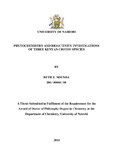| dc.description.abstract | Three Kenyan Croton species, C. megalocarpoides Friis and Gilbert, C. alienus Pax and C.
sylvaticus Hochst were investigated for their phytochemistry and biological activity
relevancies. Anti-microbial activity evaluation was done on aqueous and methanol crude
plant extracts to enable selection of most active parts. Documented procedures were used to
profile the selected extracts for their phytochemical concentrations followed by fractionation
using column chromatography. The phytochemicals obtained were identified using NMR
spectroscopic techniques and subjected to various biological activity tests. Forty one
compounds (fifteen of them new) were isolated. C. megalocarpoides roots produced twenty
diterpenoids belonging to, ent-clerodane (thirteen, twelve new), abietane (three, one new) and
ent-trachylobane (four known) series. Two known triterpenoids (lupeol and acetyl aleuritolic
acid) and common phytosterols (stigmasterol and sitosterol) were also isolated. Two novel
compounds (alienusolin, a 4α-deoxyphorbol ester and crotonimide C, a glutarimide alkaloid
derivative) and nine known compounds (an alkaloid, six methylcyclohexane derivatives of
crotepoxide, a triterpenoid and a phytosterol were isolated from C. alienus leaves and roots.
From C. sylvaticus roots, seven diterpenoids belonging to clerodane (four, one new),
halimane (two known) and labdane (one known) series and a phytosterol were isolated.
Anti-microbial activity tests were done using different strains of bacteria and fungi. Candida
albicans was the most susceptible micro-organism to the crude plant extracts. C. alienus and
C. sylvaticus (root and stem bark aqueous extracts) were active at the lowest concentration
tested (25 mg / mL). C. sylvaticus stem bark (methanol extract) was the only crude extract
that inhibited the growth of a bacteria strain (Bacillus subtillis) at a concentration of 10 mg /
mL. The compounds that were isolated and assayed from C. alienus and C. megalocarpoides
were inactive to all microorganisms used (IC50 > 20µg / mL). C. alienus leaves (MeOH:
DCM, 1:1 v / v extract) is the only crude extract that showed activity against Leishmania
donovanii (IC50 = 80µg / mL). The compounds isolated from it were however inactive against
the same, L. donovanii (IC50 and IC90 > 40µg / mL). All the crude extracts and compounds
isolated and tested from C. alienus and C. megalocarpoides were inactive against D6 and
W2 strains of Plasmodium falciparum (IC50 > 4760 ng / mL); VERO (IC50 > 4760 ng / mL)
and Aedes aegypti and Anopheles gambiae larvae (LC50 and LC95 >100 ppm). The methanol
extract of C. megalocarpoides and C. sylvaticus stem barks had a low total phenolic content
(1.89 + 0.02% -1.14 + 0.01% w / w equivalent of gallic acid) and anti-oxidant activity | en_US |

